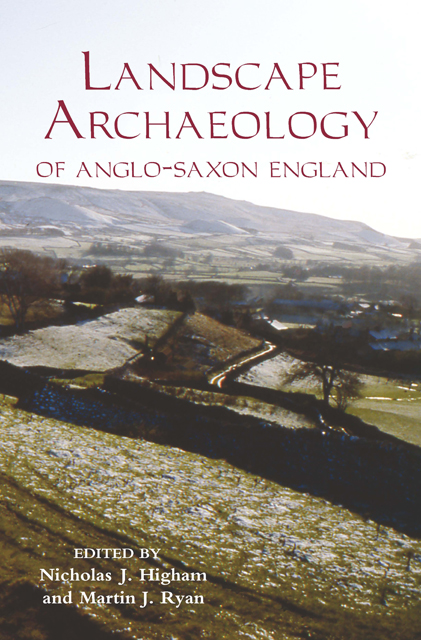Book contents
- Frontmatter
- Contents
- List of Illustrations
- Contributors
- Acknowledgements
- Abbreviations
- 1 The Landscape Archaeology of Anglo-Saxon England: An Introduction
- 2 Barriers to Knowledge: Coppicing and Landscape Usage in the Anglo-Saxon Economy
- 3 Landscape Change during the ‘Long Eighth Century’ in Southern England
- 4 Population Ecology and Multiple Estate Formation: The Evidence from Eastern Kent
- 5 Exploring Black Holes: Recent Investigations in Currently Occupied Rural Settlements in Eastern England
- 6 Medieval Field Systems and Settlement Nucleation: Common or Separate Origins?
- 7 The Environmental Contexts of Anglo-Saxon Settlement
- 8 Calendar Illustration in Anglo-Saxon England: Realities and Fictions of the Anglo-Saxon Landscape
- 9 The Anglo-Saxon Plough: A Detail of the Wheels
- 10 ‘In the Sweat of thy Brow Shalt thou eat Bread’: Cereals and Cereal Production in the Anglo-Saxon Landscape
- 11 The Early Christian Landscape of East Anglia
- 12 The Landscape and Economy of the Anglo-Saxon Coast: New Archaeological Evidence
- Index
4 - Population Ecology and Multiple Estate Formation: The Evidence from Eastern Kent
Published online by Cambridge University Press: 16 February 2023
- Frontmatter
- Contents
- List of Illustrations
- Contributors
- Acknowledgements
- Abbreviations
- 1 The Landscape Archaeology of Anglo-Saxon England: An Introduction
- 2 Barriers to Knowledge: Coppicing and Landscape Usage in the Anglo-Saxon Economy
- 3 Landscape Change during the ‘Long Eighth Century’ in Southern England
- 4 Population Ecology and Multiple Estate Formation: The Evidence from Eastern Kent
- 5 Exploring Black Holes: Recent Investigations in Currently Occupied Rural Settlements in Eastern England
- 6 Medieval Field Systems and Settlement Nucleation: Common or Separate Origins?
- 7 The Environmental Contexts of Anglo-Saxon Settlement
- 8 Calendar Illustration in Anglo-Saxon England: Realities and Fictions of the Anglo-Saxon Landscape
- 9 The Anglo-Saxon Plough: A Detail of the Wheels
- 10 ‘In the Sweat of thy Brow Shalt thou eat Bread’: Cereals and Cereal Production in the Anglo-Saxon Landscape
- 11 The Early Christian Landscape of East Anglia
- 12 The Landscape and Economy of the Anglo-Saxon Coast: New Archaeological Evidence
- Index
Summary
One of the more widely encountered narratives of territorial development in early medieval England focuses on the existence of large multi-vill estates in the Early to Middle Anglo-Saxon period (c.400–850) and their subsequent fragmentation into the smaller manorial units recorded by Domesday Book. The details of these multiple or federate estates are not entirely clear, nor is the theory itself uncontroversial. However, there remains a consensus that the early medieval productive landscape was organized into large territories from which tribute was extracted through important central places. The essential features of these territories were the links created between functionally differentiated settlements and the core, and the range of resources over which they lay claim, commonly combining arable areas of lowland with pastoral uplands. In some instances these linked settlements came to be fossilized in place-name or boundary evidence recorded in charters, suggesting that multiple estates were well-defined functional units incorporating economic and administrative roles.
A number of recent studies have shown the complex evolution of such estates and have highlighted the dangers of assuming greater uniformity than may have existed in the organization of landscape. By conflating administrative, economic and social links underlying estate structure, these studies have argued that the model as a concept conceals rather than reveals variations in territorial organization and the dynamics by which these have come about. In contrast to Jones’ original thesis, which argued that the multiple estate was a relict feature of Celtic organization, these studies have stressed the need to see it as part of a process in the evolution of lordship over the course of the early medieval period. Tim Unwin, for example, suggested that multiple estates may have been created in areas outside those initially settled by Anglo-Saxons as a way of recolonizing peripheral regions that had been depopulated during the fifth and sixth centuries. John Blair, by contrast, saw them very much as a secondary stage in the evolution of kingdoms in which large and complex estates were created through the internal division of larger tribal regiones.
In keeping with the emphasis in recent writings on the multiple estate, this paper seeks to explore the dynamism underlying landscape evolution during the fourth to ninth centuries.
- Type
- Chapter
- Information
- The Landscape Archaeology of Anglo-Saxon England , pp. 65 - 82Publisher: Boydell & BrewerPrint publication year: 2010
- 1
- Cited by



